
Vehicle-sharing and micro-mobility soon became a trend had brought tremendous success to entrepreneurs that jumped into a crazy ride by establishing a company in this field. Bird reached a $1 billion valuation in seven months, thus becoming the fastest startup ever to reach unicorn status. Lime reached unicorn status in 18 months. This year Helbiz plans to become the first micro-mobility company listed on NASDAQ. Vehicle-sharing and micro-mobility are still on the rise and it is still possible to create a successful business.
According to McKinsey & Company's "Micromobility’s 15,000-mile check-up" report, market potential by the year 2030 is:
- $200 billion to $300 billion in the United States;
- $100 billion to $150 billion in Europe;
- $30 billion to $50 billion in China.
This equals about a quarter of McKinsey & Company's forecasted global shared autonomous-driving market potential of roughly $1,600 billion in 2030. So if you are considering starting your own business with sharing, this is the right time to do it. But let's look at how leaders are doing, the milestones of their business success, and the trends they are setting for the future in the sharing business.
The fastest double unicorn ever
The company Bird attained this status soon after it was founded in September 2017 by Travis VanderZanden. He was already familiar with the market as previously he had worked as an executive at Lyft and Uber. Bird got its first round of funding in February 2018 raising $15 million. Series B round followed in March for $100 million. And the funding round of $150 million in May granted the fastest ever unicorn status. In June 2018, Bird raised an additional $300 million, valuing the company at $2 billion. Prior to Bird, this valuation had never been reached so fast by any startup. Currently, its valuation is estimated at $2.3 billion. Bird has raised $765 million in total funding across five funding rounds. It plans to reach $308 million gross profit by 2023.
Bird is a last-mile electric scooter rental service. What is important here - the company has reached its success with just one vehicle type while others have been adding several types of vehicles to their portfolio. Bird operates in 200 cities globally. Overall more than 95 million rides have been made up to date.

Bird started its business by offering customers a Xiaomi M365 scooter. With the launch of the BirdOne model, the company stopped buying and distributing Segway models.
The price for the service is €1 or $1 (depending on the country) to unlock the scooter. A one-minute ride on the scooter costs €/$0.15. There is also a monthly fee available for renting a scooter - $25. However, prices may vary depending on the country, currency, and local laws.
At the beginning of this year, Bird introduced Global Ride Pass - new pricing plans designed to save money and accelerate the shift away from cars for short-distance trips. Currently, there are four new Global Ride Pass options available:
- Daily Unlimited Rides Pass
- Monthly Unlimited Rides Pass
- Monthly Unlimited Unlocks Pass
- 3-Month Unlimited Unlocks Pass
In the second half of 2020, the company launched Bird Pay that is piloted in two California hubs. This provides users with the opportunity to pay via the Bird app for the purchase in local shops, restaurants, or food trucks as they move around on the scooter.
This year Bird announced that the company is investing $150 million in Europe. The company said that funds will be used to open safe, sustainable micro-mobility programs in over 50 new European cities. The company is also planning to go public by merging with special purpose acquisition company Switchback II. However, it is not yet clear when this could happen.
Alex Wilhelm, a journalist at TechCrunch wrote in 2018 that Bird’s gross margin is 19 percent. He explored that revenues are split as follows - 47% charging, 14% repairs, 11% credit card processing, 5% regulatory costs, and 3% customer support and insurance.
Runner up for the unicorn status
Lime is the brand of the transportation company Neutron Holdings, Inc., previously known also as LimeBike. The company is based in San Francisco, USA. In comparison with Bird, Lime’s vehicle-sharing business takes different forms: electric scooters, electric bikes, regular pedal bikes, electric mopeds, and car-sharing systems in various cities around the world. Lime operates with dockless vehicles that users find and unlock via a mobile app. It finds the location of available vehicles via GPS.
Lime was founded in January 2017 by Brad Bao and Toby Sun - former executives of the venture capital firm Fosun International. Over a period of two months, the company raised US$12 million in venture funding led by Andreessen Horowitz. Lime's first location was the University of North Carolina at Greensboro and they launched with 125 bicycles. In October 2017 the company closed a Series B round. Afterward Lime announced that it was valued at $225 million. It became a unicorn in 2018 following a $335 million funding round and $1.1 billion valuations. To date, Lime has raised $935 million in total funding across five rounds.
Lime operated in more than 120 cities over 30 countries as of September 2019. It started 2020 with the announcement that it had added 11 locations to this list, including several US metropolitan areas such as Atlanta. In the first quarter of 2021 Lime announced that it has allocated $50 million to its bike-share operation, an investment that has been used to develop a new e-bike and will fund its expansion this year to another 25 cities in North America, Europe, Australia, and New Zealand.
This announcement came a month after Lime announced plans to add electric mopeds to its micromobility platform. Lime is launching the effort by deploying 600 electric mopeds on its platform in Washington, D.C. The company is also working with officials to pilot the mopeds in Paris. Lime mopeds are manufactured by NIU, a Chinese company that also supplies mopeds to New York City-based mobility company Revel. NIU’s mopeds typically have a range of between 25–100 miles. Lime’s mopeds will be speed limited to 28 mph and can be controlled and monitored via wireless connectivity.
Lime uses many different manufacturers for the production of bikes and scooters. Other vehicles in Lime's fleet include:
- Lime-S electric scooters - four different models are currently in use: Lime-S Ninebot ES4, made by Segway with the extra battery attached on to the Main Pole, Lime-S Generation 1, Lime-S Generation 2, Lime-S Generation 3, Lime-S Generation 4.
- Lime-E electric-assist bikes.
- LimeBike - the classic dock-free bicycle.
- LimePod - colorfully branded Fiat 500s, a small, two-door model.
The fee to start any Lime ride is $1.00 and has to be paid no matter what. Afterwards, the user has to pay per minute to ride. Charges are rounded up to the nearest minute and rates and promotions. Users also pay $1 to unlock the car and an additional 40 cents per minute they drive.
In May 2021 Lime rolled out a new monthly subscription service for its electric scooters named Lime Prime. For $5.99 a month, users won't have to pay an initial fee. And in markets with no unlock fees, riders will receive 25 percent off the price of their ride. Subscribers will still pay the per-minute charge, but Lime says that someone who uses one of its scooters every day would save approximately $25 a month under the subscription plan.
Lime made its first quarterly profit in Q3 in 2019 according to Reuters. Wayne Ting, CEO of Lime said that the company generated positive free cash flow in the third quarter, having exited some markets where it was losing money, optimized the operation of its two-wheelers, and cut head office costs. “With these improvements, I believe we’re on track to be fully profitable in the full year 2021,” he told Reuters in an interview.
With micro-mobility to NASDAQ
The first company providing micro-mobility services and making up to NASDAQ seems to be Helbiz. It operates in North America and Europe. With more than 200 employees around the world, the company is the market leader in Italy and it operates e-scooters, e-bicycles and e-mopeds in over 20 cities around the world including Washington D.C., Alexandria, Arlington, Atlanta, Miami, Richmond, Milan and Rome. Helbiz was founded on 16 October 2015 by Italian serial entrepreneur, Salvatore Palella and was the first company to introduce the shared electric scooter model in Italy back in October 2018 through the legalization and regulation of the electric scooters in Italy.
Helbiz announced the intention to have a public offering on NASDAQ and on the Borsa Italiana AIM Italia exchange. In August 2019, the company announced it has completed the initial investment round for approximately $7.13 million. In October 2019, Forever Sharing, a China-based company producing electric smart mobility vehicles has acquired 5% of the Helbiz. This Chinese company invested 8 million dollars in Helbiz by valuing it at 160 million dollars. As a result, Forever Sharing agreed to supply Helbiz with 20,000 electric bicycles and e-scooters by the end of 2019 and the beginning of 2020 to deploy globally. There was no IPO.
Helbiz has raised a total of $56.9M in funding over 10 rounds. The company’s revenues reached nearly $4 million in 2020 but it plans to have $449M revenue by 2025.

Helbiz offers three vehicle types - e-scooters, e-bikes, and e-mopeds. The company offers the same payment plan for their customers as its competitors - users pay $1 to unlock the vehicle and an additional 30 cents per minute. The exception is the e-moped that charges only 26 cents per minute. Also Helbiz has an unlimited program that costs 29.99 a month.
Helbiz is planning to move forward by using penetration and user base to launch new products - public transit integration & ticketing, HelbizKitchen food delivery, and Native Wallet & Payment System. The company is in the process of obtaining its fintech license in Europe.
To sum it all up:

There is a lot we can learn from the success of these big companies. However, they usually focus on big cities with huge populations, complicated infrastructure, and a big investment required to launch there. At the same time, all over the world small cities are seeking to improve their micro-mobility capabilities. And this is the opportunity. ATOM team will take care of the software - one of the most complicated parts of this business. As we have several years of experience in the vehicle sharing business, we would also be happy to help with any other questions you might have. It is possible to start quickly and launch a vehicle-sharing business in next to no time. Here is the link to our blog. You will find a lot of helpful information there.
P.S. Useful links:
Bird investor presentation: Click here
Helbiz investor presentation: Click here
Click below to learn more or request a demo.
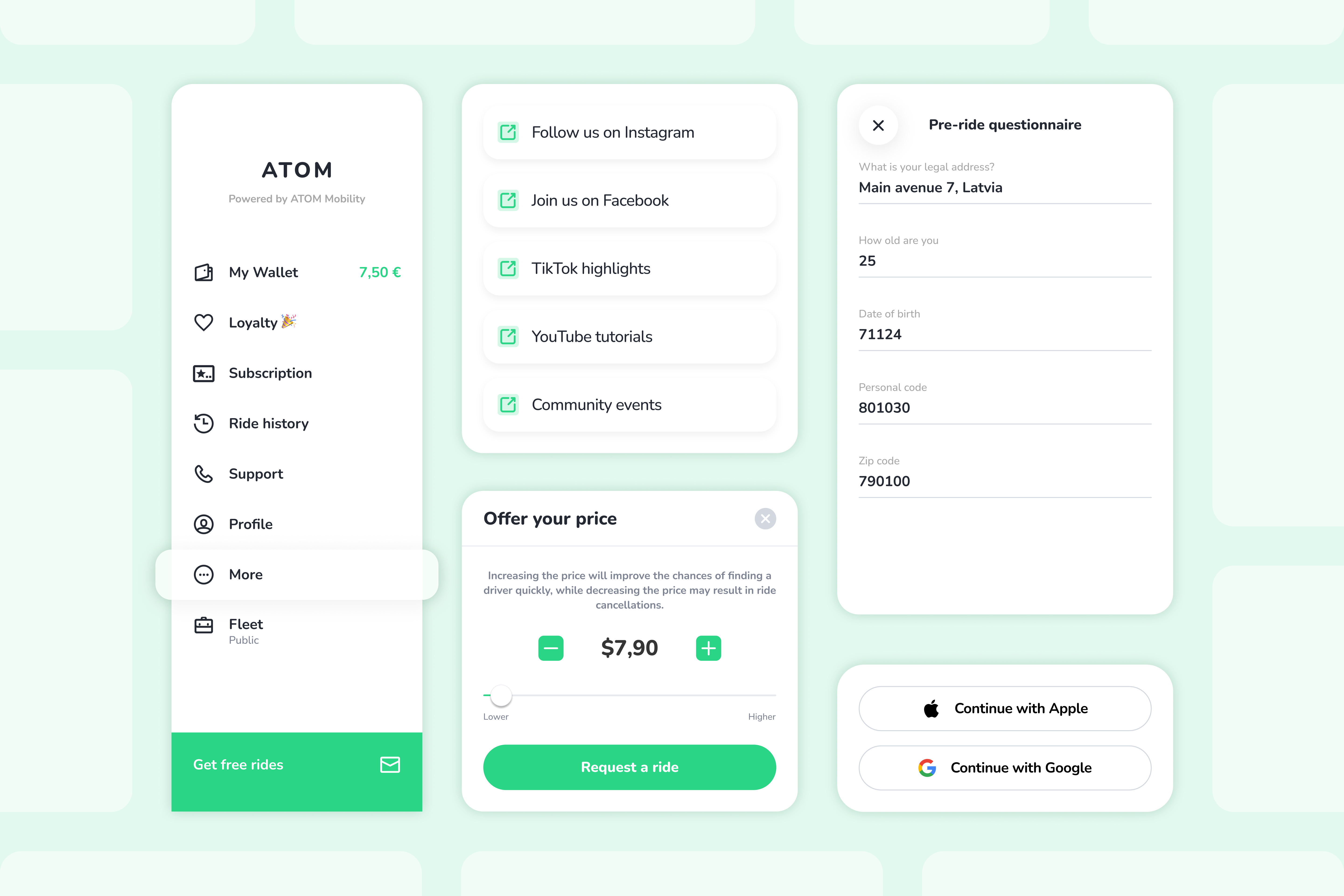
🚀📱2025 was all about automating more and reducing friction across mobility. ATOM Mobility introduced OpenAPI, new sign-in flows, a rental web-booker, smarter fleet automation, and a wide range of new hardware and payment integrations. A faster, more flexible, more scalable mobility platform - built for operators who want to grow.
2025 has been a defining year for shared mobility, digital rentals, and ride-hailing. Competition is stronger, operational costs are rising, and users expect instant, reliable digital experiences. Operators who succeed are the ones who automate more, reduce friction, and stay flexible with hardware, payments, and integrations.
This year, ATOM Mobility shipped a series of features designed to help operators achieve exactly that:
grow revenue, reduce costs, improve fleet quality, and scale into new markets with less complexity.
Here are the 10 most impactful (out of more than 70) features ATOM Mobility released in 2025, and why they matter.
1. OpenAPI (supported by all 3 modules - vehicle sharing, digital rental and ride-hail)

The launch of ATOM’s OpenAPI marks a major step forward for operators seeking greater flexibility, automation, and integration possibilities.
What it is
A fully documented API layer allowing operators and partners to build custom flows, integrations, booking systems, analytics dashboards, or MaaS connections on top of ATOM Mobility.
Who it helps
All verticals: micromobility, car-sharing, moped sharing, rentals, ride-hail, and enterprise partners.
How it works
OpenAPI enables third-party developers to build on top of the ATOM Mobility infrastructure, allowing seamless integrations with external apps, internal tools, and automated workflows. With OpenAPI, operators can extend their service in almost any direction: a partner app (like FreeNow or Uber) can show your vehicles, unlock them, and process payments on your behalf; or internal systems can trigger automated actions - such as sending a survey email after every completed ride. The possibilities are nearly unlimited, giving operators full flexibility to innovate and scale however they choose.
Why it matters
- Enables deeper integrations with partners and local platforms
- Supports custom business logic and automations
- Makes it easier to enter new markets with local-specific requirements
- Opens the door to MaaS distribution and enterprise collaborations
2. Sign-In with Apple & Google - A smoother first-time user experience (all modules)

Across mobility, the registration flow is often the first point of friction. ATOM Mobility introduced modern authentication options to simplify onboarding.
What it is
One-tap sign-in using Apple ID or Google Account instead of relying solely on SMS verification.
Who it helps
All operators - especially those targeting tourists, or markets with unreliable SMS delivery.
How it works
When creating a new account or logging in, users can choose to log in/register using Apple ID or Google Account - this will allow account creation in just 2 taps.
Why it matters
- Faster user onboarding experience -> happier rider -> more frequent rides
- Fewer SMS-related issues (and lower SMS related costs) and failed verifications
- Reduced support load from login problems
3. Multipurpose side menu button (all modules)

What it is
A customizable slot in the app menu where operators can add up to five external links - websites, ecommerce pages, tour pages, extra FAQ pages, social media, partner offers, etc.
How it works
- Enable in Settings → System preferences → External links
- Add titles + URLs
- Links automaticaly appear in the app under “More”
Value for operators
- A space where you can display any information you consider important for the user
- Supports cross-promotion and partnership campaigns
- Allows communication updates without app releases
- Creates additional monetisation opportunities, such as launching your own e-commerce or merchandise shop
4. Pre-ride questionnaire (all modules)
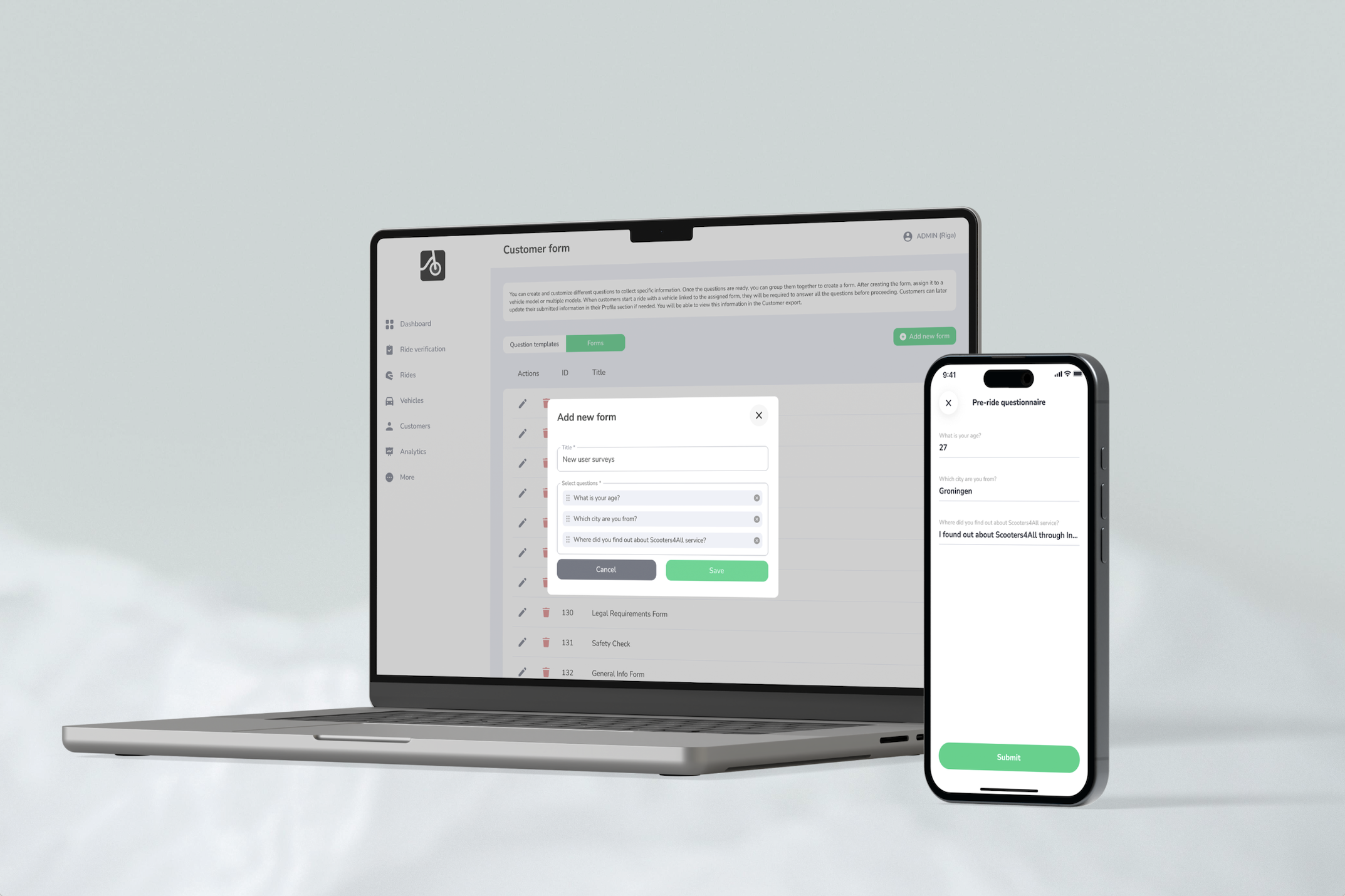
What it is
A form that users must complete before starting a ride - ideal for compliance, reporting, invoicing, or gathering important data.
Who it helps
Operators needing regulatory data, reporting, consent collection, or structured user feedback.
How it works
Create a question (or several) in “Customer form” -> Group questions into a pre-ride form -> Assign a form to specific vehicle models/classes.
Once completed, the customer must answer predefined questions before starting the ride. Their responses appear in both customer and ride exports. For example, you can ask for a personal ID code, legal address, or any other required information.
Value for operators
- Helps meet regulatory or municipal requirements
- Ensures correct invoicing details
- Provides a structured way to capture essential user data
5. Driver revenue auto-distribution (Stripe & Adyen, ride-hail)
What it is
Automatic payout splitting: driver earnings go to the driver’s payout account, and platform commission goes to the operator - all processed automatically after each ride.
Who it helps
Ride-hail operators using Stripe or Adyen.
How it works
- Operator has a Stripe/Adyen merchant account
- Drivers onboard as payout recipients
- After completed rides, payouts split automatically
- Supports mixed payment methods (cash and non-cash)
Value for operators
- Reduces manual payout work
- Minimises accounting errors
- Improves driver experience through transparency and instant pay out
- Makes scaling easier when the driver base grow
6. Set a manual vehicle location (vehicle sharing & digital rental)
What it is
A tool to override or manually set a vehicle’s GPS position when IoT data is unavailable (no IoT placed on the vehicle at all) or inaccurate.
Who it helps
Operators with underground parking, poor GPS coverage, or long-term rentals without IoT can use this setup. A typical scenario is long-term bike rental without IoT: the user completes ID verification, payment, and booking in the app, then sees the vehicle assigned to a predefined location (station) where it is picked up and later returned. This serves as a workaround for vehicles that do not support IoT or where adding IoT device is too costly.
How it works
Edit vehicle → update “Location” field. The system assumes this as the correct coordinate. Works for individual vehicles or via mass import.
Value for operators
- Avoids user frustration when vehicles appear in the wrong location
- Supports business modesl with fleets operating without IoT devices
7. Offer your price - rider-controlled pricing (ride-hailing)
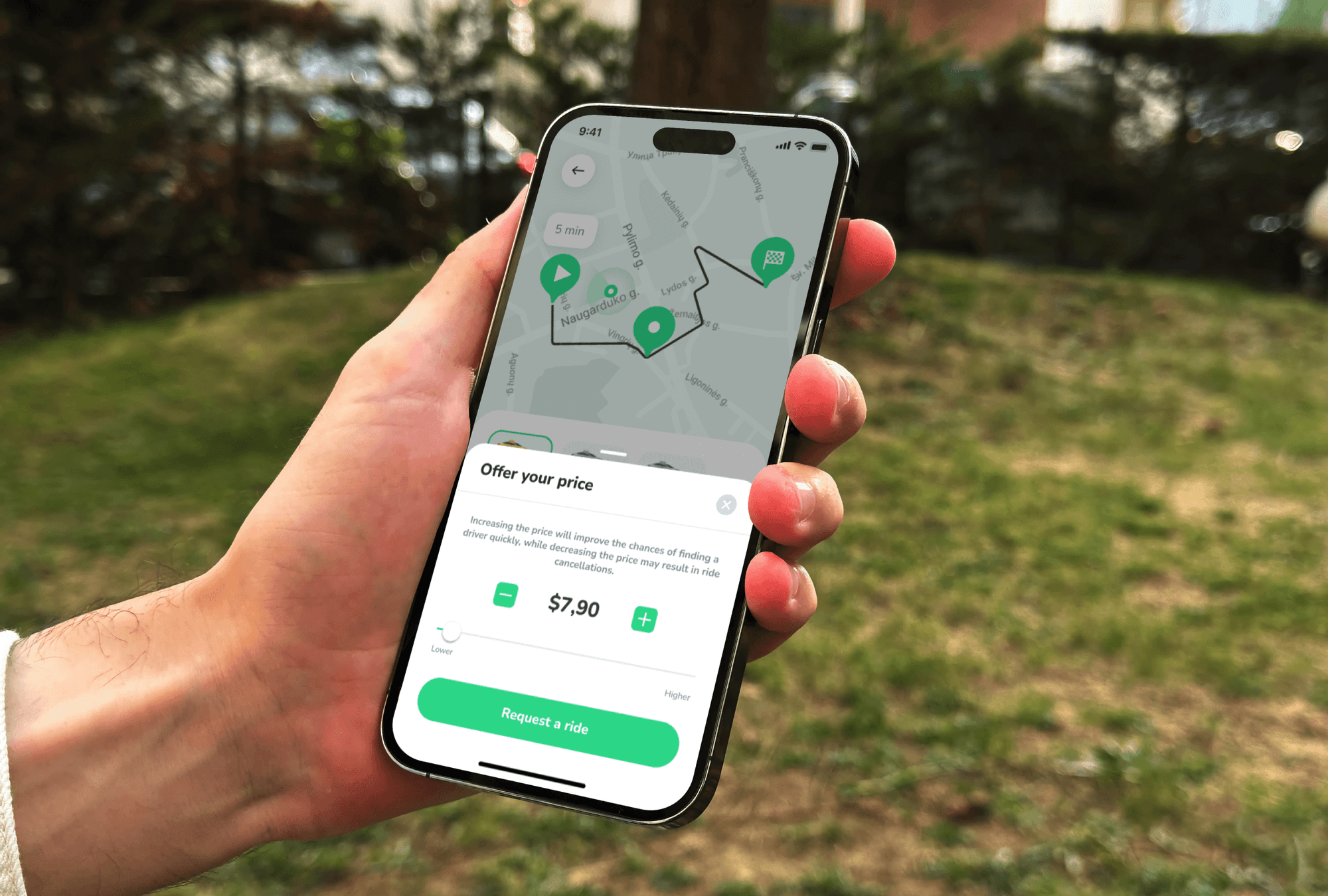
What it is
A flexible pricing feature that lets passengers propose their own fare - higher or lower than the system-calculated price, within limits set by the operator. Drivers see the offer instantly and can choose to accept or reject it.
Who it helps
Ride-hailing operators in competitive, price-sensitive, or highly dynamic markets where price shifts demand quickly.
How it works
When requesting a ride, the user selects “Offer your price”. A slider or +/– buttons allow them to adjust the fare within operator-defined boundaries. If the user lowers the price, the app explains that the offer may reduce the chance of driver acceptance.
Drivers see a clear banner showing whether the rider is offering more or less than the standard fare. Drivers can accept or decline based on their preference.
Operators can enable or disable the feature per vehicle class.
Why it matters
- Creates a clear differentiator in markets dominated by fixed-fare competitors
- Helps convert riders who compare multiple apps before booking
- Gives drivers more control over their earnings and decisions, improving transparency and satisfaction
- Supports better ride matching during off-peak hours or less profitable routes
- Allows operators to experiment with more flexible pricing strategies without changing their core fare model
8. Web-booker for digital rental - frictionless bookings directly from your website (digital rental)
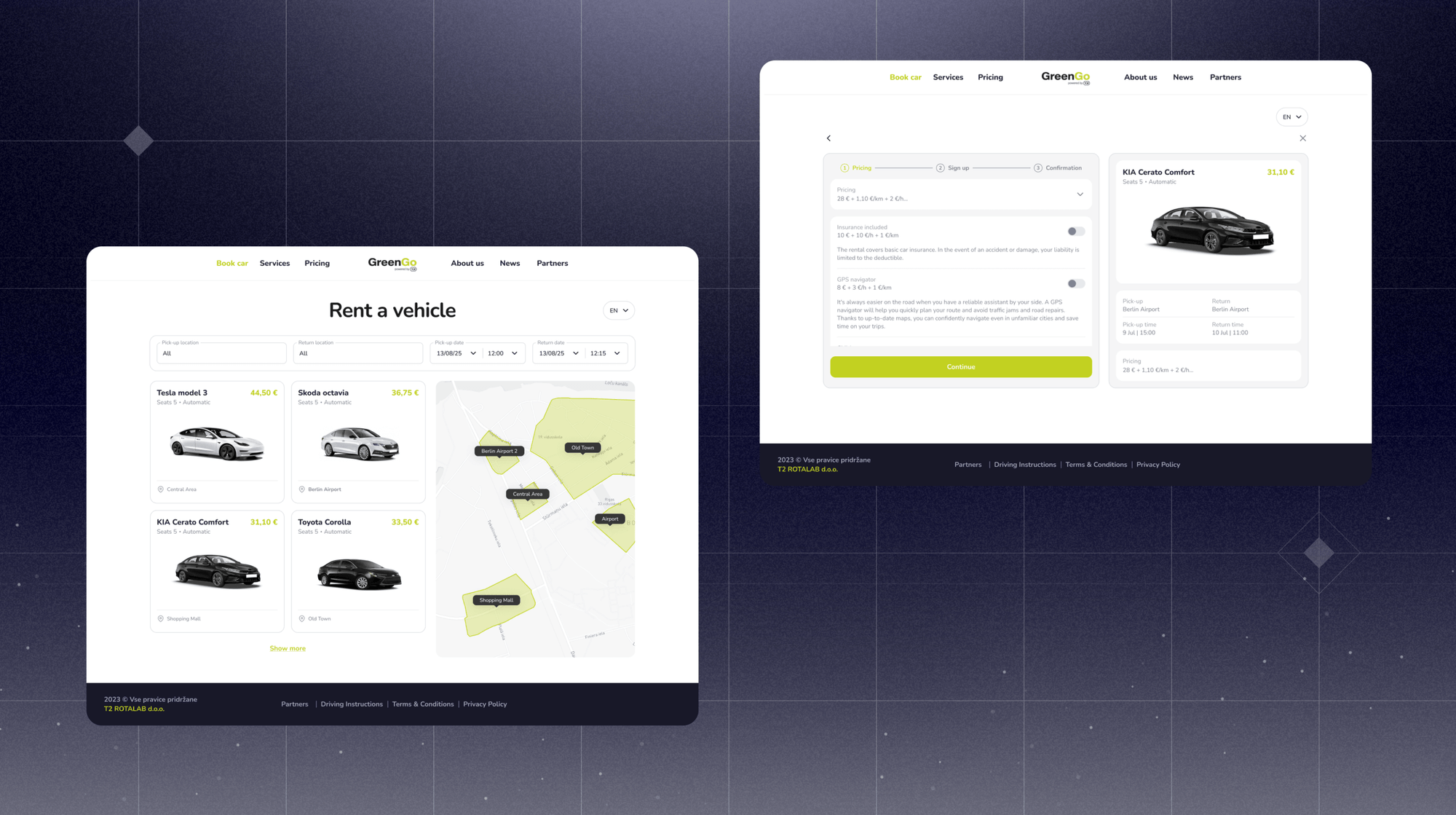
What it is
A lightweight, embeddable booking widget that lets customers reserve a rental vehicle directly from your website - without installing the mobile app first. It’s designed to capture spontaneous bookings, convert website visitors, and unify online and in-app rental experiences.
Who it helps
Car, moped, and bike rental operators, as well as hospitality and tourism partners such as hotels, resorts, coworking spaces, real-estate developers, and travel service providers.
How it works
Every operator receives a branded rental URL: merchantname.atommobility.com/rent
Users select their area, vehicle type, and rental period directly in the widget. Once confirmed and the account created, the booking syncs automatically into the ATOM Mobility dashboard. Customers see a confirmation screen with a QR code to open the booking in the mobile app. Payment, ID verification, and vehicle unlock actions are completed in the ATOM Mobility-powered app before the trip begins.
The widget automatically adapts to the operator’s brand color for a visually seamless integration. In the dashboard, each booking displays its source: App, Web, or Booker - helping operators track where rentals originate.
Why it matters
- Converts first-time users browsing your website into paying customers - without forcing an app install
- Enables plug-and-play rental flows for partners such as hotels, rental desks, cafés, coworking spaces, or tourist spots
- Supports QR-based rental journeys from physical locations
- Reduces friction for users who want a fast, simple booking experience
- Helps operators expand distribution with minimal effort, unlocking new sales channels
- Unifies online and mobile rental flows under a single backend and operational system
Demo: https://app.atommobility.com/rental-widget
9. Vehicle status change automation (vehicle sharing & digital rental)

What it is
Bad user experiences often happen when several riders encounter the same faulty vehicle. ATOM Mobility now prevents this automatically. Automation rules detect problematic vehicles and instantly set them to “Needs investigation,” hiding them from the user app so the operator can inspect the vehicle before the next rider can take it.
Who it helps
Sharing and rental operators managing medium or large fleets.
How it works
System monitors low ratings, repeated short rides, and user reports. When triggered, it:
- creates a maintenance task
- switches vehicle status
- hides the vehicle from users
Why it matters
- Prevents recurring complaints from the same issue
- Reduces refunds and reputational damage
- Helps maintain a healthier, more reliable fleet
- Automates routine operational checks
10. New integrations (10) - a broader ecosystem for hardware, payments & compliance (all modules)
What was added
2025 brought a wave of new integrations that give operators more flexibility in choosing hardware, payments, charging, and regulatory tools. What was added:
- Ridemovi IoT
- Wave payment gateway
- Linka smart lock support
- 2Hire IoT
- Kuhmute charging stations
- Eskiz.uz OTP service
- Atmos payment gateway
- Chiron API (regulatory)
- Fitrider charging station
- Azericard payment gateway
Why it matters
- Easier entry into markets with local payment or OTP requirements
- More hardware options for scooters, bikes, e-bikes, and cars
- Better compatibility with charging infrastructure
- Reduced integration time when expanding
- Support for regulatory compliance where required
These ten features represent only a small selection of what we delivered this year. In total, our team shipped more than 70 new features, dozens of integrations, and countless small improvements that quietly make the platform faster, more stable, and more enjoyable for operators and end-users every single day. Behind each release is a team focused on one idea: helping entrepreneurs build stronger, more efficient, and more profitable mobility businesses.
And we’re just getting started.
Our 2026 tech pipeline is already packed with ambitious and exciting solutions - from deeper AI-powered automation to smarter fleet intelligence and new tools that will change how operators run mobility services. We're looking forward to pushing the industry even further together.
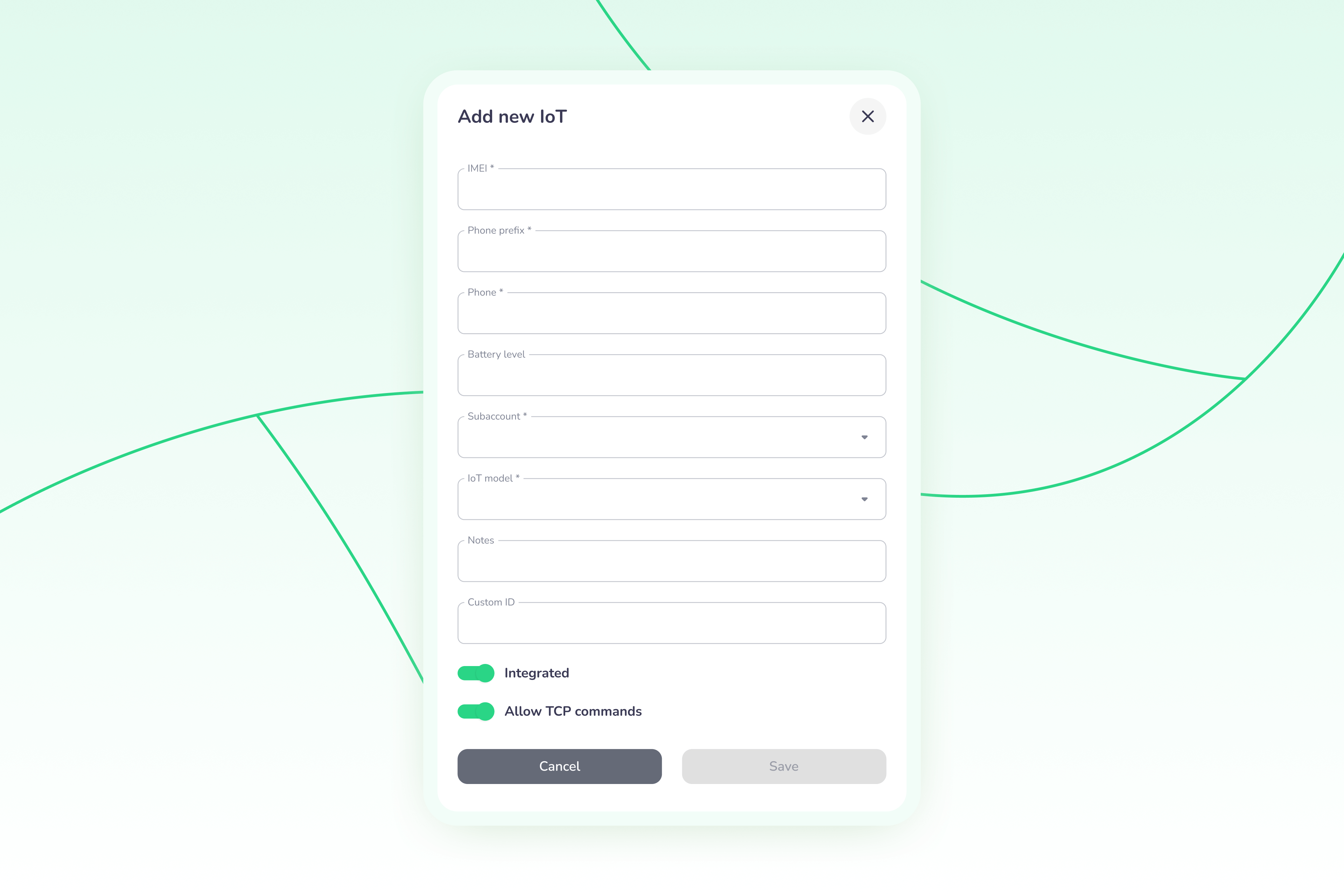
🛴📡 That smooth ride you just took? It was powered by a whole ecosystem of hardware and software you never saw. From IoT modules in the vehicle to real-time dashboards and rider apps, shared mobility relies on a solid tech stack to stay online, secure, and profitable.
You open an app, spot a scooter on the map, and within seconds it unlocks with a click. You ride off, expecting the battery to be charged, the brakes to work, and the whole process to feel effortless. From the very first ride, shared mobility set the standard: vehicles should always be nearby, ready to go, and the whole experience should feel seamless. What most riders never think about, though, is the complex mix of hardware and software working in the background to make every smooth ride possible.
Why the tech matters
Technology is the baseline for the shared mobility business model. Every ride depends on it. Vehicles need IoT hardware to lock, unlock, and report their status. Connectivity has to be stable so operators always know where assets are and what condition they’re in.
On the software side, riders expect apps that feel instant and intuitive, while operators rely on dashboards for fleet health, pricing, and support. Add in the realities of theft, battery swaps, downtime, and local regulations, and the stakes become clear. Without a reliable tech stack, even small failures – a scooter that won’t unlock or a payment that stalls – can quickly break user trust and hurt the business.
Where it began
Over the years, several manufacturers have entered the shared mobility IoT space, offering different hardware configurations, network technologies, and integrations. Companies like Teltonika (Lithuania), Comodule (Estonia), Invers (Germany), OMNI (China) and others produce modules compatible with various vehicle types and connectivity standards. Each provider focuses on specific strengths – some prioritize energy efficiency or compact design, others emphasize global coverage or advanced diagnostics. Choosing between them depends on the type of vehicles, operational scale, and software ecosystem an operator plans to use.
Our partner, Comodule was already developing IoT for micromobility when the Corona pandemic hit. Overnight, cities shifted and everyone needed their own safe, private way to move around. Shared scooters and bikes suddenly went from being a niche service to an essential part of urban transport, and the demand for IoT skyrocketed. For IoT manufacturers, it meant long days in development and manufacturing, pushing hard to deliver reliable devices at scale for brands like Uber, Lime, and Hive.
That sharp rise in demand forced them to grow quickly and gave valuable experience in building technology that could perform under real pressure. Fleets that trusted Comodule devices had a backbone they could rely on: vehicles that could be located, unlocked, secured, and managed internationally. Just as important, the IoT had to integrate seamlessly with software systems (like ATOM Mobility). That’s why building robust API and SDK tools became critical – enabling operators to connect hardware to their platforms, control fleets in real time, and access the information needed to keep moving.

IoT as the brain of the vehicle
Inside every connected scooter or bike sits a IoT module, the “brain” that links the vehicle to the cloud. It connects through cellular networks, constantly sending data about location, speed, and battery status. When a rider taps “unlock” in the app, that command travels through the cloud to the module, which triggers the electronic lock and wakes up the vehicle. The same connection allows operators to set geofenced no-parking zones, push over-the-air updates, or activate a sound alarm if the scooter is being tampered with. Battery sensors inside the module report charging cycles and health, so operators know exactly when a pack needs to be swapped or replaced.
All of this data is streamed in real time to the fleet management system, giving providers the ability to monitor hundreds or even thousands of vehicles simultaneously. For operators, these capabilities mean higher uptime, faster theft recovery, and precise control over the entire fleet – the difference between running a struggling operation and a profitable one.
Rising expectations in the market
As shared mobility matured, the bar kept getting higher. New scooter generations came with swappable batteries, sturdier frames, and better onboard electronics. Riders got used to apps that respond instantly, process payments in seconds, and show vehicle availability with pinpoint accuracy.
At the same time, competition rose, not only from global players but also from smaller, local operators launching fleets in their own cities. For these companies, reliable hardware was no longer enough. They needed the software layer that connects everything: smooth rider apps, powerful operator dashboards, and analytics to make smarter decisions. Yet many lacked the time and resources to build software on their own.

Software as the missing piece
As fleets grew and competition intensified, operators realized they did not have time or funds to develop their own software layer. They needed a market-ready platform that ties everything together – apps that riders enjoy using and dashboards that give operators full control of their business. That’s where solutions like ATOM Mobility come in.
Platform connects directly with Comodule IoT through APIs and SDKs, so every unlock command, error code, or battery update flows instantly between the rider’s app and the operator’s dashboard. Almost any company can launch a fleet with this stack – from large-scale operators to small, local newcomers.
The power of integration
When hardware and software work seamlessly, the rider experience feels effortless. A simple tap in the app sends a command through the cloud to IoT, which unlocks the vehicle and streams live data back in milliseconds. The operator instantly sees the vehicle’s status in the dashboard: battery level, GPS position, and any error codes.
If the scooter leaves a geofenced area, the system reacts automatically. If maintenance is needed, the alert is flagged before it becomes a breakdown. By combining the hardware with software, fleet providers get one complete ecosystem – a stack built to keep vehicles online and users satisfied.
From seamless rides to smarter cities
From a rider’s perspective, shared mobility should always “just work.” That won’t change. But the technology stack behind it is becoming more sophisticated every year. Stricter regulations demand safer and more transparent services, while cities are pushing for integration into broader Mobility-as-a-Service platforms. IoT and software together provide the data and control that operators need, not only to stay compliant but also to improve fleet efficiency and sustainability and to provide insights for city planning.
For users, that sophistication will translate into something simple: services that are more reliable, safer for everyone on the road, and smarter – with data from real-world usage helping to shape better vehicles, better infrastructure, and better cities in the future.
*This article was created together with our partner Comodule.


